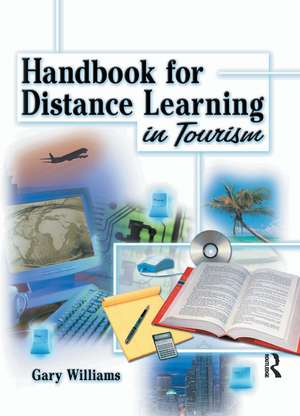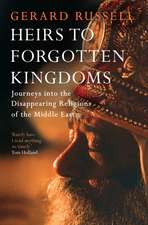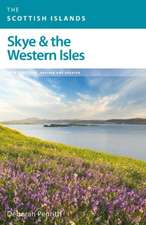Handbook for Distance Learning in Tourism
Autor Kaye Sung Chonen Limba Engleză Hardback – 27 iul 2005
The Handbook for Distance Learning in Tourism is a practical, down-to-earth guide to developing and using print-based and Internet-based flexible learning resources for courses where students rarely, if ever, attend on-campus classes. Whether you’re a teacher who needs to develop course notes into a flexible learning package, a Web site, or both, or you just want information about how to teach in a flexible environment, the book will provide the help you need-in language you can understand. Designed to guide you through the completion of a project—or a semester—this hands-on book offers strategies, suggestions, hints, and examples, and includes a hotel and tourism case study that illustrates effective concepts and strategies.
Written by Gary Williams, co-editor of The Internet and Travel and Tourism Education (Haworth), this unique book will help you develop print-based and Internet-based learning resources instead of focusing only on one or the other, breaking down the barriers placed between learning environments. The strategies presented are timeless, with no comparisons of specific commercial or noncommercial products to become outdated and no Web site addresses to become useless. The book makes extensive use of tables, graphics, and illustrations and has its own Web site that’s regularly updated, listing online resources arranged on a chapter-by-chapter basis.
The Handbook for Distance Learning in Tourism examines:
- the roles and characteristics of a project manager
- developing and buying resources
- considerations before committing to a project
- maximizing project ownership
- ensuring quality content
- educational design guidelines
- media foundations
- production, design, and maintenance of print resources
- developing and using Web sites
- computer-mediated contact
- course management systems (CMS)
- and much more!
The Handbook for Distance Learning in Tourism is an invaluable guidebook for educators working in the field of hotel and tourism management as well as academics, project managers, and educational designers who are interested in flexible learning developments.
Preț: 766.24 lei
Preț vechi: 1155.79 lei
-34% Nou
Puncte Express: 1149
Preț estimativ în valută:
146.64€ • 152.53$ • 121.06£
146.64€ • 152.53$ • 121.06£
Carte tipărită la comandă
Livrare economică 12-26 aprilie
Preluare comenzi: 021 569.72.76
Specificații
ISBN-13: 9780789018595
ISBN-10: 0789018594
Pagini: 266
Dimensiuni: 148 x 210 x 22 mm
Greutate: 0.57 kg
Ediția:1
Editura: Taylor & Francis
Colecția Routledge
Locul publicării:Oxford, United Kingdom
ISBN-10: 0789018594
Pagini: 266
Dimensiuni: 148 x 210 x 22 mm
Greutate: 0.57 kg
Ediția:1
Editura: Taylor & Francis
Colecția Routledge
Locul publicării:Oxford, United Kingdom
Cuprins
- Preface
- Acknowledgments
- Chapter 1. Introduction to Flexible Learning and the Case Study
- Objectives
- Topic 1.1: What Is a Flexible Learning Environment?
- Topic 1.2: Maximizing the Return on Investment
- Topic 1.3: Introducing the Case Study
- Topic 1.4: The Development Model
- Key Points
- Chapter 2. The Project Manager
- Objectives
- Topic 2.1: Every Project Has a Manager
- Topic 2.2: The Role and Characteristics of a Project Manager
- Topic 2.3: Project Management Aids
- Topic 2.4: The Project As Organized Chaos
- Key Points
- Chapter 3. Starting a Project
- Objectives
- Topic 3.1: The Spark
- Topic 3.2: Developing and Buying Resources
- Topic 3.3: The Project Team
- Topic 3.4: Stakeholder Meetings
- Topic 3.5: Maximizing Project Ownership
- Topic 3.6: Considerations Before Committing to a Project—A Self-Appraisal for Teachers
- Key Points
- Chapter 4. Educational and Design Foundations
- Objectives
- Topic 4.1: Introduction
- Topic 4.2: Constructivism—A Theory of Knowledge
- Topic 4.3: Ensuring Quality Content
- Topic 4.4: Educational Design Guidelines for Learning Resources
- Topic 4.5: Writing a Course Outline
- Topic 4.6: Copyright
- Key Points
- Chapter 5. Media Foundations
- Objectives
- Topic 5.1: Introduction
- Topic 5.2: The Teacher Is Essential
- Topic 5.3: Determining the Needs, Wants, and Technology Access of Students
- Topic 5.4: Secondary Determinants—Teacher, Institution, and Course Factors
- Topic 5.5: Using Media Instead of a Medium
- Key Points
- Chapter 6. Developing Print Resources
- Objectives
- Topic 6.1: Introduction
- Topic 6.2: Advantages and Disadvantages of Print Learning Resources
- Topic 6.3: Production
- Topic 6.4: Design
- Topic 6.5: Maintenance and Revision
- Key Points
- Chapter 7. Developing and Using Web Sites
- Objectives
- Topic 7.1: Introduction
- Topic 7.2: Advantages and Disadvantages of Web Sites
- Topic 7.3: Using the World Wide Web
- Topic 7.4: Production
- Topic 7.5: Design
- Topic 7.6: Maintenance and Revision
- Key Points
- Chapter 8. Computer-Mediated Contact
- Objectives
- Topic 8.1: Introduction
- Topic 8.2: The Advantages and Challenges of Computer-Mediated Contact
- Topic 8.3: Teachers’ Roles
- Topic 8.4: Training and Support Roles
- Key Points
- Chapter 9. Course Management Systems
- Objectives
- Topic 9.1: Introduction
- Topic 9.2: The Advantages and Challenges of Course Management Systems
- Topic 9.3: A Teacher’s Perspective—Using A Course Management System
- Topic 9.4: Training and Support Roles
- Key Points
- Chapter 10. Teaching in a Flexible Learning Environment
- Objectives
- Topic 10.1: Introduction
- Topic 10.2: Before a Course Starts
- Topic 10.3: The Start of a Course
- Topic 10.4: During a Course
- Topic 10.5: The Responsibilities of Educational Designers
- Key Points
- Chapter 11. Being a Student in a Flexible Learning Environment
- Objectives
- Topic 11.1: Introduction
- Topic 11.2: The Advantages and Challenges of Flexible Learning
- Topic 11.3: You Have Enrolled in a Flexible Learning Course—What Now?
- Topic 11.4: Making the Most of Learning Resources
- Key Points
- References
- Index
Descriere
The Handbook for Distance Learning in Tourism is a practical, down-to-earth guide to developing and using print-based and Internet-based flexible learning resources for courses where students rarely, if ever, attend on-campus classes. Whether you're a teacher who needs to develop course notes into a flexible learning package, a Web site, or both, or you just want information about how to teach in a flexible environment, the book will provide the help you need—in language you can understand. Designed to guide you through the completion of a project—or a semester—this hands-on book offers strategies, suggestions, hints, and examples, and includes a hotel and tourism case study that illustrates effective concepts and strategies.
To view an excerpt online, find the book in our QuickSearch catalog at www.HaworthPress.com.
To view an excerpt online, find the book in our QuickSearch catalog at www.HaworthPress.com.






